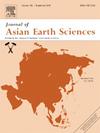High slab thermal gradient facilitates dehydration and megathrust ruptures in the Solomon Sea plate
IF 2.7
3区 地球科学
Q2 GEOSCIENCES, MULTIDISCIPLINARY
引用次数: 0
Abstract
Devastating earthquakes tend to occur in the eastern portion of the Solomon Sea, while small–medium events are distributed along the entire margin. The process controlling megathrust ruptures along this convex slab remains enigmatic in terms of both its nature and the manner of its control. Through 3D modeling, we find a high temperature gradient on the obliquely oriented flank of the convex slab, providing new insights into the tectonics of curved trench subduction. The subduction slab temperature gradient reaches as high as > 10 °C/km, and the dehydration gradient exceeds 0.05 wt%/km, which is associated with the recurrence of M > 7.5 earthquakes in frequently ruptured megathrust faults. The subducted plate immediately beneath the Moho depth of the overriding plate, corresponding to the source region of the largest number of seismic events at a depth of 30 ∼ 40 km, exhibits peak values in both the slab thermal gradient and dehydration gradient, revealing previously unrecognized intrinsic correlations.

求助全文
约1分钟内获得全文
求助全文
来源期刊

Journal of Asian Earth Sciences
地学-地球科学综合
CiteScore
5.90
自引率
10.00%
发文量
324
审稿时长
71 days
期刊介绍:
Journal of Asian Earth Sciences has an open access mirror journal Journal of Asian Earth Sciences: X, sharing the same aims and scope, editorial team, submission system and rigorous peer review.
The Journal of Asian Earth Sciences is an international interdisciplinary journal devoted to all aspects of research related to the solid Earth Sciences of Asia. The Journal publishes high quality, peer-reviewed scientific papers on the regional geology, tectonics, geochemistry and geophysics of Asia. It will be devoted primarily to research papers but short communications relating to new developments of broad interest, reviews and book reviews will also be included. Papers must have international appeal and should present work of more than local significance.
The scope includes deep processes of the Asian continent and its adjacent oceans; seismology and earthquakes; orogeny, magmatism, metamorphism and volcanism; growth, deformation and destruction of the Asian crust; crust-mantle interaction; evolution of life (early life, biostratigraphy, biogeography and mass-extinction); fluids, fluxes and reservoirs of mineral and energy resources; surface processes (weathering, erosion, transport and deposition of sediments) and resulting geomorphology; and the response of the Earth to global climate change as viewed within the Asian continent and surrounding oceans.
 求助内容:
求助内容: 应助结果提醒方式:
应助结果提醒方式:


